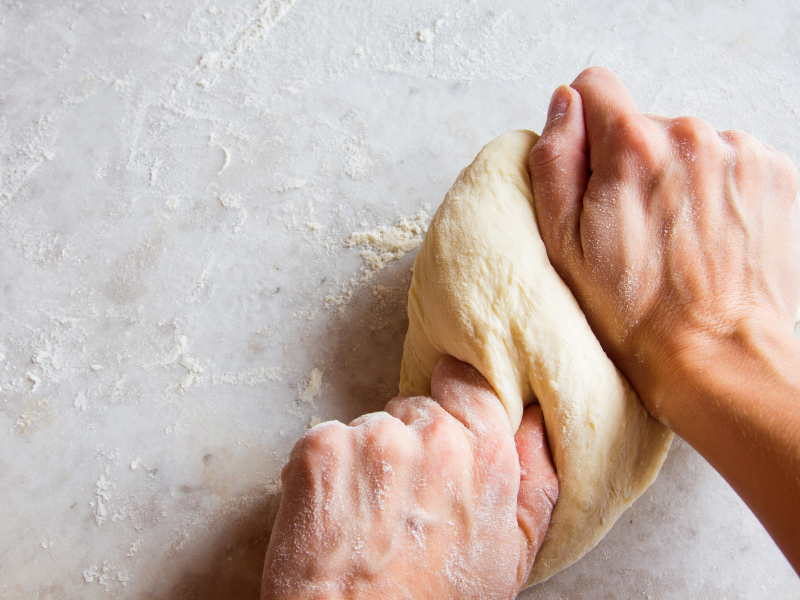
Why Kneading is Crucial for Whole Wheat and Bread Flours
Share
Key Takeaways
- Kneading Importance: Kneading is essential for developing the gluten network necessary for well-risen, airy bread, especially when using whole wheat and bread flours.
- Whole Wheat Flour Challenges: Whole wheat flour contains bran and germ, which can interfere with gluten formation, requiring more kneading and hydration.
- Bread Flour Benefits: Bread flour has a higher protein content, making it ideal for creating a strong, elastic dough that rises well and holds its shape.
- Effective Kneading Techniques: Hand kneading, using a stand mixer, and the stretch and fold method are all effective techniques for kneading dough.
- Properly Kneaded Dough: Properly kneaded dough should be smooth, elastic, and slightly tacky, with a well-developed gluten network that can be tested using the windowpane test.
- Practice Makes Perfect: Experimenting with different kneading techniques can help you find the best method for your baking needs, improving your homemade bread.
Bread making is a timeless craft that many of us enjoy, and at the heart of it is the simple, yet vital, act of kneading. If you're baking with whole wheat or bread flours, knowing why kneading is so important can make a big difference in the quality of your loaf.
In this article, we’ll explore the science of kneading, especially for whole wheat and bread flours, and share some effective techniques and tips. Whether you're an experienced baker or just starting out, understanding the importance of kneading can help you create better homemade bread and improve your overall bread-making skills.
The Science Behind Kneading
Kneading is a key part of bread making because it helps form gluten, which is crucial for good bread. Gluten, a protein found in whole wheat and bread flours, forms when flour and water mix. When you knead the dough, the proteins glutenin and gliadin bond together, creating a stretchy network of gluten strands.
This network gives the dough its elasticity and strength, allowing it to stretch and trap gases produced by yeast during fermentation. If you don’t knead the dough properly, the gluten network won’t develop well, resulting in dense and poorly risen bread.
Gluten is essential for giving bread its structure and texture. As you knead, the gluten strands align and stretch, forming a web that holds air bubbles. These air bubbles create the light, airy crumb and chewy texture we love in good bread. A well-developed gluten network also helps the dough hold its shape as it rises and bakes, leading to bread with good volume and a tender yet firm structure. This is especially important when working with whole wheat and bread flours, as these types of flour need thorough gluten development to make a great loaf.
There are some differences between whole wheat flour and bread flour that affect how you should knead them.
Bread flour, made from hard wheat, has a higher protein content, usually around 12-14%. This means it can form more gluten, resulting in a stronger dough that rises higher and holds its shape better.
Whole wheat flour, however, includes all parts of the grain, like the bran and germ. These can interfere with gluten formation, making it harder to develop a strong gluten network. This means whole wheat dough often needs more kneading and sometimes extra hydration to achieve the right elasticity and strength.
Knowing these differences helps you adjust your kneading techniques to suit the flour you’re using, ensuring you get the best results for your homemade whole wheat bread.

Why Kneading is Essential for Whole Wheat Flour
Whole wheat flour stands out because it contains all parts of the wheat grain: the bran, germ, and endosperm. This gives it a higher fiber content and more nutrients compared to white flour. However, these extra components make whole wheat flour a bit trickier to work with when baking bread. The bran and germ, while nutritious, can interfere with gluten development, making the dough denser and harder to handle. That’s why kneading is especially crucial for whole wheat dough—it helps build the gluten network needed for a well-risen, airy loaf.
One of the main challenges in developing gluten in whole wheat dough is the presence of the bran and germ, which can cut through the gluten strands and weaken the dough’s structure. Whole wheat dough often needs more kneading than dough made with white bread flour to develop a strong gluten network. Additionally, whole wheat flour absorbs more water, so it’s important to ensure the dough is adequately hydrated to help the gluten develop. Without enough kneading and hydration, the dough can become tough and difficult to rise, leading to a dense and heavy bread.
To knead whole wheat dough effectively, there are a few techniques you can use.
First, try the autolyse method, which involves mixing the flour and water and letting it rest before adding salt and yeast. This rest period allows the flour to fully hydrate and the gluten to start developing on its own, making the kneading process easier and more effective.
Another technique is the stretch and fold method, which gently develops the gluten network without overworking the dough. This method is particularly useful for whole wheat dough, as it helps maintain the dough’s elasticity while promoting a strong gluten structure.
By understanding and using these techniques, you can overcome the challenges of working with whole wheat flour and create delicious, well-textured homemade whole wheat bread.

Importance of Kneading for Bread Flour
Bread flour is designed with a higher protein content, usually around 12-14%, which is key for gluten development. This makes bread flour perfect for creating a strong, elastic dough that traps air bubbles effectively. These properties are crucial for achieving a light, airy texture in your bread. When you knead bread flour dough, the gluten network becomes more structured and elastic, allowing the dough to rise higher and hold its shape better during baking. This is why bread flour is the go-to choice for making loaves with good volume and a chewy, satisfying crumb.
Kneading bread flour dough brings several benefits that significantly enhance the quality of your bread. The kneading process fully hydrates the flour, ensuring that all the proteins are adequately absorbed by water, which is vital for optimal gluten formation. As you knead, the dough becomes smoother and more elastic, making it easier to work with and shape. Additionally, well-kneaded dough has better fermentation, as the gluten network traps the gases produced by yeast, leading to a good rise and excellent texture. Proper kneading also enhances the bread's flavor by allowing the yeast to work more efficiently throughout the dough.
When comparing kneading bread flour to whole wheat flour, there are some notable differences. Bread flour, with its higher gluten potential, generally requires less kneading time to develop a strong dough compared to whole wheat flour. Whole wheat flour contains bran and germ, which can disrupt gluten formation and require more kneading and hydration to achieve a similar texture. While both types of flour benefit from the kneading process, the techniques and duration may vary. Understanding these differences helps us adjust our methods to suit the specific flour we are using, ensuring the best results whether we are working with bread flour or whole wheat flour.
Techniques for Effective Kneading
There are several effective techniques for kneading dough, each with its unique benefits.
Hand kneading is the traditional method, involving pushing, folding, and stretching the dough to develop gluten. This technique lets you feel the dough's texture and elasticity change as you work.
If you prefer a hands-off approach, using a stand mixer with a dough hook can be incredibly efficient. It kneads the dough evenly and thoroughly, saving you time and effort.

Another popular method, especially for high-hydration doughs like whole wheat, is the stretch and fold technique. This gentle method involves stretching the dough and folding it over itself multiple times, allowing gluten to develop without overworking the dough.

Knowing when your dough is properly kneaded is key to successful bread making. One simple test is the "windowpane test." Take a small piece of dough and gently stretch it between your fingers. If it forms a thin, translucent film without tearing, the gluten is well-developed.
Another indicator is the dough's texture; properly kneaded dough should be smooth, elastic, and slightly tacky to the touch. Additionally, well-kneaded dough will hold its shape and spring back when lightly pressed with a finger. These visual and tactile cues are essential for ensuring your dough is ready for fermentation and baking.
Mastering these kneading techniques and knowing how to identify properly kneaded dough can significantly improve your bread-making skills. Whether you prefer the tactile feedback of hand kneading, the efficiency of a stand mixer, or the gentleness of the stretch and fold method, each technique can help you achieve a strong gluten network and a perfect loaf. By paying attention to the dough's texture and elasticity, you can ensure that your homemade bread rises beautifully and has a delightful crumb and chewiness.
To wrap things up, kneading is a crucial step in bread making, especially when using whole wheat and bread flours. It develops the gluten network that gives your bread its rise and airy texture. By practicing and perfecting your kneading techniques, whether it's hand kneading, using a stand mixer, or the stretch and fold method, you can greatly enhance your homemade bread. We encourage you to try these methods and see what works best for you. Share your experiences and any questions you have in the comments section—we'd love to hear from you and help you on your journey to baking the perfect loaf of homemade whole wheat bread!

